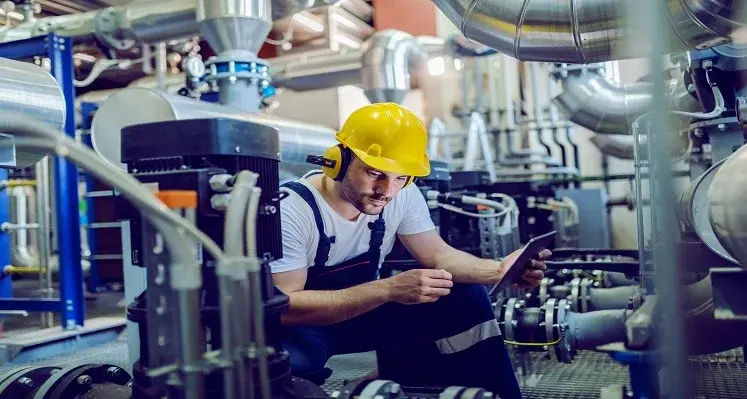CO2 benchmarking is a crucial yet underutilised process that can steer the oil and gas industry towards more sustainable practices, says Nikhil Aremanda, head of Asia at MachineMax
The Middle East's oil and gas sector, a pivotal player in the global energy landscape, faces an unprecedented challenge: reducing its carbon emissions in a world increasingly intolerant of environmental degradation. The path to sustainability is fraught with obstacles, yet it also offers a blueprint for transformation, centring around data’s role as a catalyst for innovation. Streamlining data integration, promoting collaboration, and establishing standardised practices can unlock data’s true potential.
For instance, CO2 benchmarking is a crucial yet underutilised process that can steer the industry towards more sustainable practices. The industry's struggle with data utilisation has compounded sustainability challenges, leaving much to be desired when attempting to develop a more agile approach to operational practices, especially regarding one of its most emission-intensive facets: heavy machinery.
Doing the heavy lifting
Heavy machinery is indispensable for extraction and production processes, yet it also serves as a significant source of carbon emissions due to its energy-intensive nature. Traditional methods of managing these emissions have relied on retrospective data analysis, often conducted months later. This delay hampers the industry's ability to respond swiftly to inefficiencies, leading to unnecessary emissions.
Additionally, this data, while extensively covering various operational metrics, such as pressure and temperature of drilling fluids, seldom focuses on energy consumption - a critical oversight given the potential savings in emissions and costs. One of the root causes of this inefficiency is the absence of standardised CO2 benchmarking and data practices. Without a unified approach to measuring and comparing emissions, the sector remains fragmented, unable to leverage its data for more sustainable operations. As a result, both the environment and firms pay a high price.
A new intelligent era
The advent of artificial intelligence (AI) and machine learning (ML) technologies heralds a new era for the industry, offering sophisticated tools for data analysis and management. Telematics and advanced data solutions can automate the tracking of machinery usage, providing invaluable insights into metrics like performance, fuel consumption, and operator behaviours. These technologies represent a significant leap from traditional, manual data collection methods, which are not only cumbersome but also prone to inaccuracies.
However, implementing these technologies is insufficient without a solid CO2 benchmarking framework. Such a framework would enable the industry to systematically measure its emissions against established standards, fostering a culture of accountability and continuous improvement. The current lack of such a framework, coupled with the challenges of data fragmentation, leaves the industry without a clear direction for reducing its carbon footprint.
Pooling resources
The industry must embrace a holistic approach to data management and benchmarking to maximise operational efficiency. This involves streamlining data integration processes, promoting collaboration across the sector and establishing standardised data practices. By doing so, the industry can ensure consistent data interpretation, eliminate manual errors and facilitate effective decision-making based on accurate, real-time information.
Central to this transformation is the adoption of common data environments (CDEs), which consolidate siloed data into a unified platform. CDEs lay the foundations for achieving interoperability, and streamline processes by ensuring information is accessible, up-to-date and consistent. As a result, all stakeholders can access a common ground for effective communication and decision-making.
A thought-driven approach
In addition to technological and procedural changes, the industry must also focus on the human element. Understanding machine metrics and identifying patterns of operational inefficiency requires a shift in behaviour and mindset. Companies must promote operational practices that prioritise the efficient use of machinery, reducing idle time and optimising fuel consumption. This behavioural change, supported by real-time data and insights, can lead to significant emissions reductions and enhance the profitability of projects.
The journey towards lower emissions in the Middle East's oil and gas industry is complex, requiring a multifaceted strategy that combines technology, standardised practices, and behavioural change. Without a CO2 benchmarking framework in place, supported by improved levels of easily shared data, we’ll continue to see an industry with no handle on machinery emissions and, likely, a continued pattern of emission target failures. By leveraging the power of AI and ML, the industry can unlock the full potential of its data, driving significant improvements in sustainability and operational efficiency.
The urgency of the environmental challenges we face demands nothing less than a concerted effort to transform the industry. In this era of environmental accountability, the Middle East's oil and gas sector has the opportunity to not just navigate the storm of sustainability challenges, but to lead the charge in transforming adversity into innovation, proving that even the most traditional industries can pivot towards a greener horizon.










